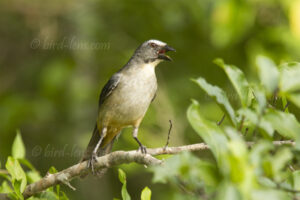 A Greyish Saltator (Saltator coerulescens) sits on the edge of a bush and spits fruit. The pulp is spilling out of the edges of its beak. I was just about to go to the sparsly vegetated gallery forest. There is a beautiful morning light. Right at the beginning, in the light forest with its cactus undergrowth, the Greyish Saltator greets me like an old acquaintance. Meanwhile there are news in taxonomy of this species. Before the recent recognition of the northern populations as distinct species, the Blue-gray Saltator (then Greyish or Grayish Saltator) had an extremely wide range. Even after the omission of the Olivaceous Saltator (Saltator olivascens) and the Cinnamon-bellied Saltator (Saltator grandis), the range of the “remaining” Saltator is still large, extending over much of the Amazon basin and southern South America east of the Andes. In most parts of its range, it is a typical, conspicuous member of the local avifauna and is common in lowland scrub and semi-open areas. For Balthasar Dubs, the species – as described in “Birds of Southwestern Brazil” – is widely distributed in the Pantanal. Plumage varies to some degree throughout its wide range, especially in the intensity of coloration on the upperparts. Immature birds have some green on the wings, which may lead inexperienced observers to confuse this species with the partially sympatric Green-winged Saltator (Saltator similis), a species essentially endemic to the Atlantic forest biome and a rare bird at least in the northwestern Pantanal, according to Dubs. There are numerous anecdotal reports of the Saltator´s feeding habits, as it is known to consume vegetative plant parts such as leaves and flower petals.
A Greyish Saltator (Saltator coerulescens) sits on the edge of a bush and spits fruit. The pulp is spilling out of the edges of its beak. I was just about to go to the sparsly vegetated gallery forest. There is a beautiful morning light. Right at the beginning, in the light forest with its cactus undergrowth, the Greyish Saltator greets me like an old acquaintance. Meanwhile there are news in taxonomy of this species. Before the recent recognition of the northern populations as distinct species, the Blue-gray Saltator (then Greyish or Grayish Saltator) had an extremely wide range. Even after the omission of the Olivaceous Saltator (Saltator olivascens) and the Cinnamon-bellied Saltator (Saltator grandis), the range of the “remaining” Saltator is still large, extending over much of the Amazon basin and southern South America east of the Andes. In most parts of its range, it is a typical, conspicuous member of the local avifauna and is common in lowland scrub and semi-open areas. For Balthasar Dubs, the species – as described in “Birds of Southwestern Brazil” – is widely distributed in the Pantanal. Plumage varies to some degree throughout its wide range, especially in the intensity of coloration on the upperparts. Immature birds have some green on the wings, which may lead inexperienced observers to confuse this species with the partially sympatric Green-winged Saltator (Saltator similis), a species essentially endemic to the Atlantic forest biome and a rare bird at least in the northwestern Pantanal, according to Dubs. There are numerous anecdotal reports of the Saltator´s feeding habits, as it is known to consume vegetative plant parts such as leaves and flower petals.
The Blue-gray Saltator, which still consists of four subspecies, is what was left of the Grayish or Greyish Saltator before this species complex was split into three separate species that were long expected. Although some earlier publications suggested this division, it was only recently accepted in the eBird/Clements checklist of birds of the world. Recently, 2021 means. again, a combination of genetic and vocal differences was decisive.
A good starting point to get to know the bird life of the northern Pantanal is the Fazenda Tereza. It is located directly on the banks of the bird-rich Rio Pixaim. The 3 kilometer long and very bumpy turnoff to the lodge is located at kilometer 63 on the Transpantaneira, just behind the Mato Grosso Hotel. This accommodation is still signposted as Fazenda Tereza. Recently, however, it was renamed to Southwild Pantanal Lodge.
To cope with the growing demand for top shots of the rarer species of the Palearctic Bird-Lens is keen to enrich the range of pictures of birds you can find in the western palearctic and beyond. Trips to remote places like this one to capture images not only of rare birds of western palearctic were very successful. The nice image of the blog is only a first impression, what you will find in the gallery in the “Picture Shop” very soon. Just give bird-lens.com a message, if bird-lens.com could serve you with an image needed before the new pictures are online.